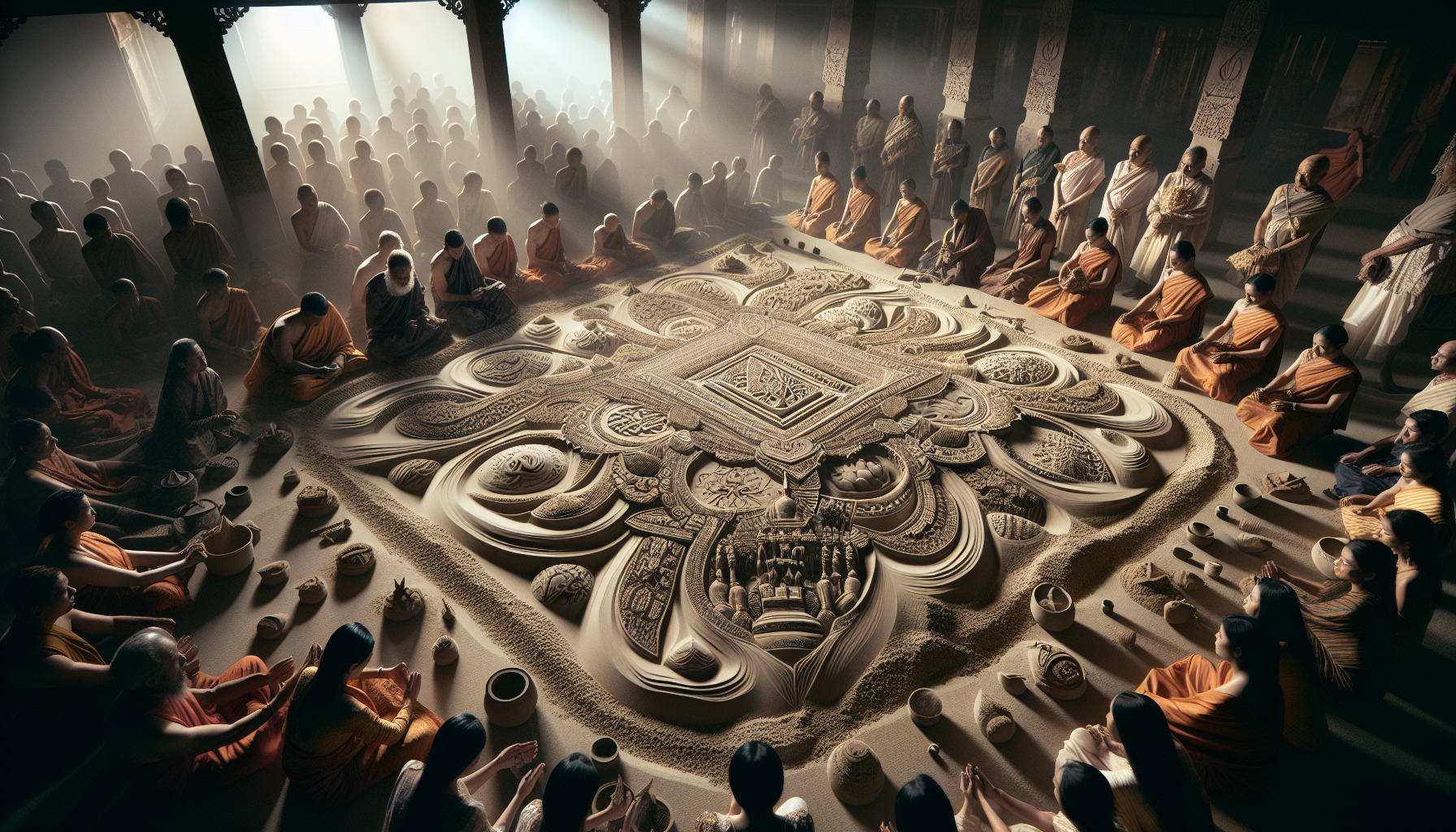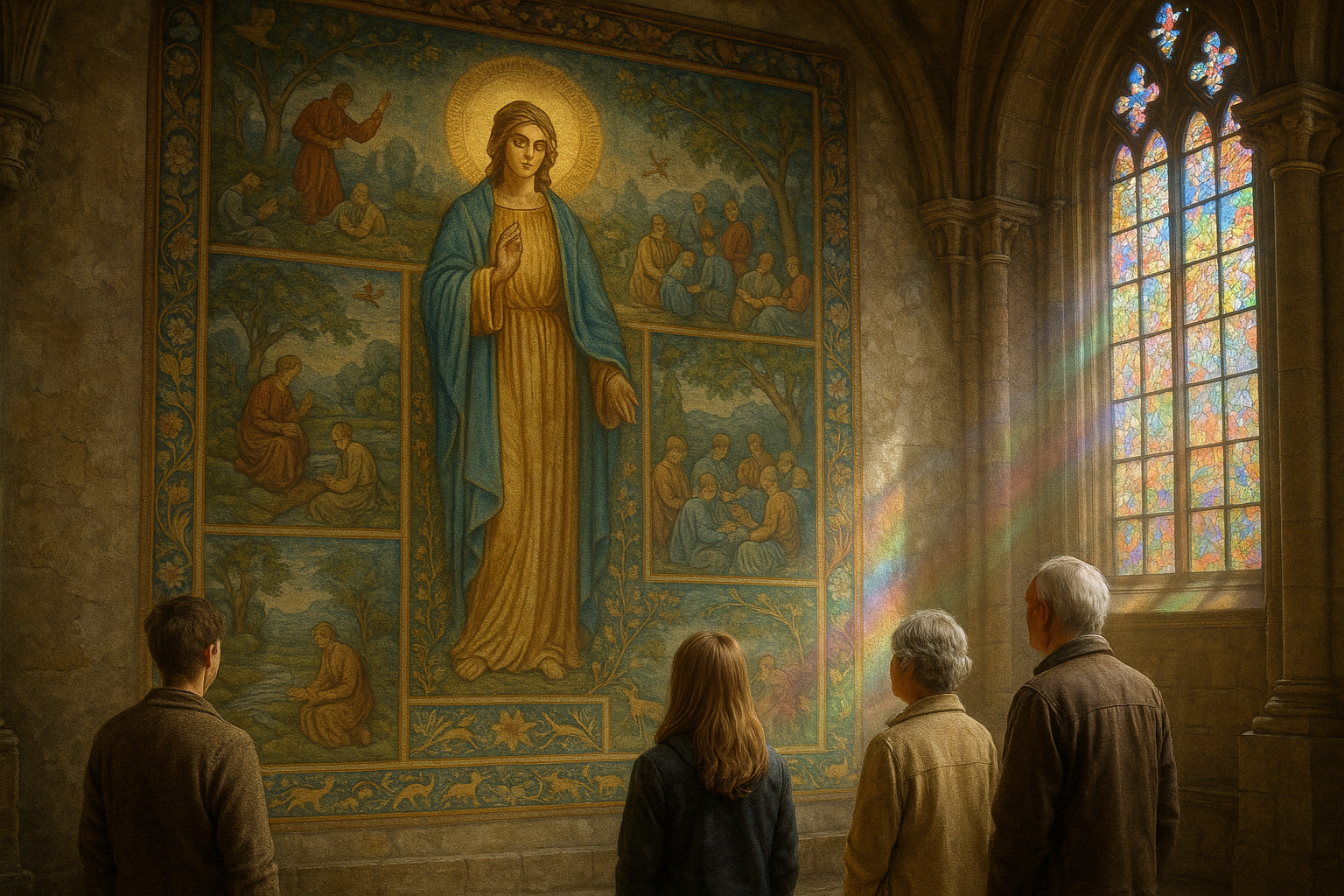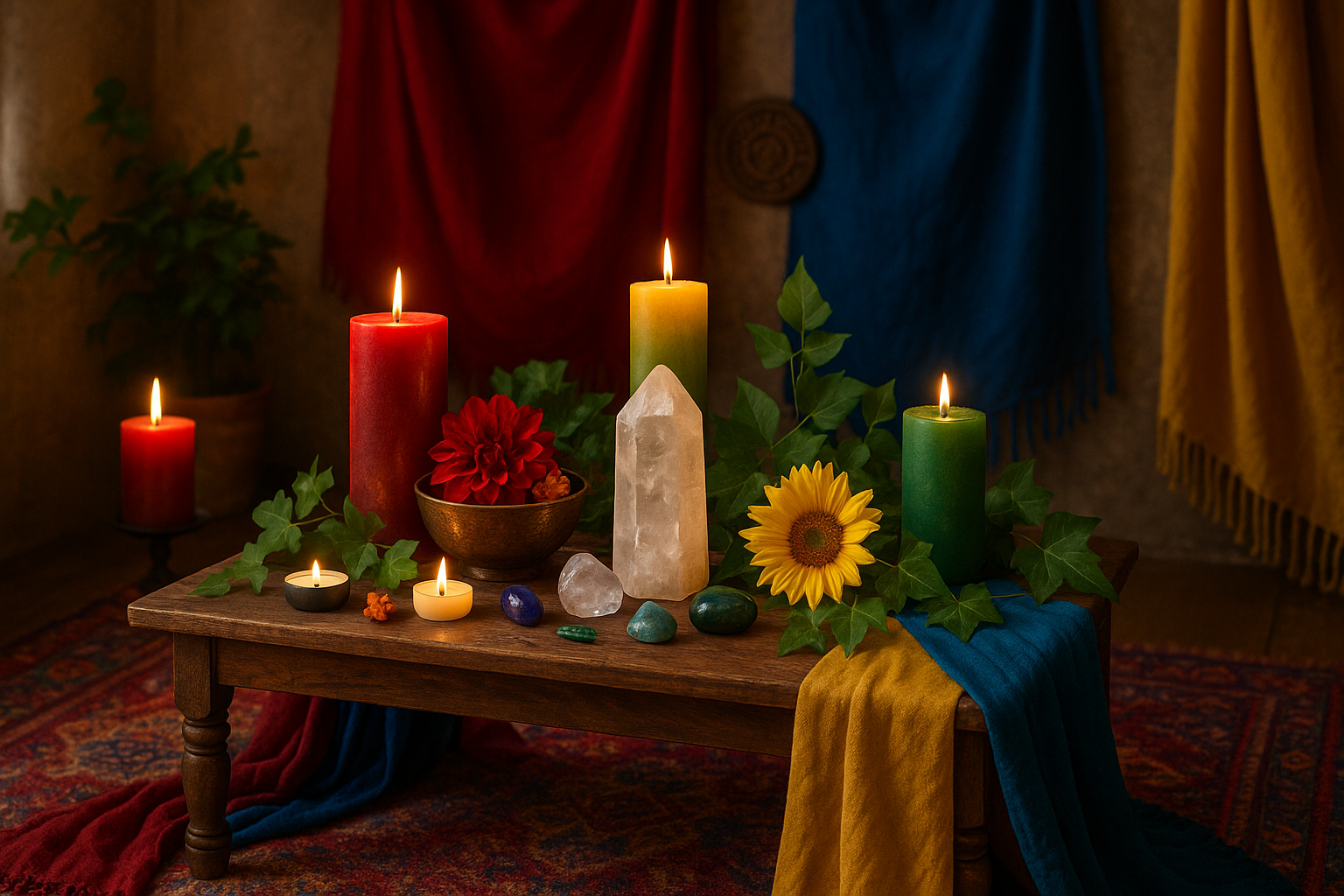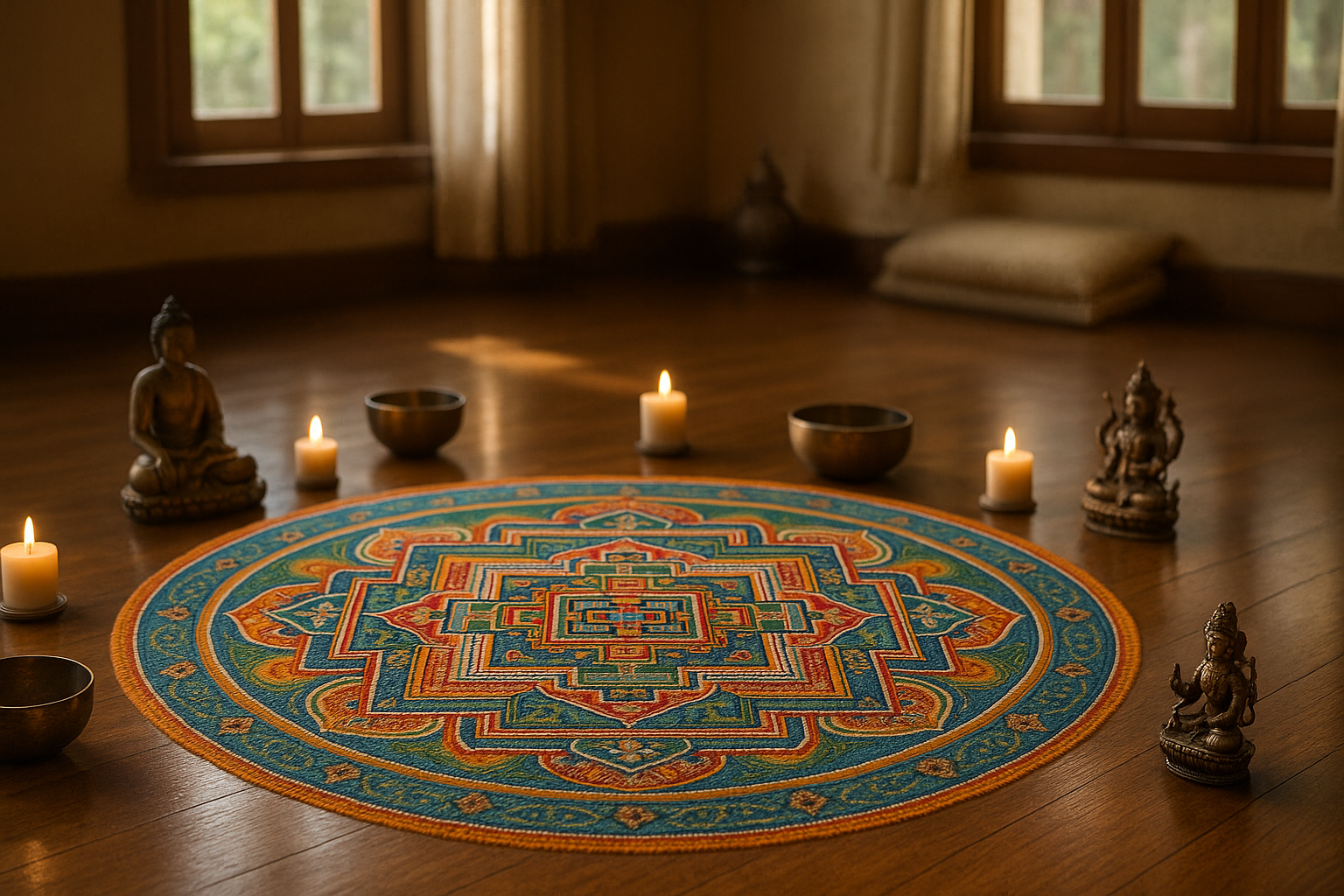In the vast tapestry of human culture, few art forms captivate the imagination quite like the ethereal and ephemeral beauty of sand drawings. 🌾 From the sacred rituals of indigenous tribes to the intricate ceremonies performed in modern settings, sand drawings hold a mesmerizing allure that transcends time and geography. These intricate designs, often crafted with painstaking precision and an understanding of both art and nature, have served as a medium for storytelling, spiritual reflection, and community bonding for countless generations. As we delve into the world of sand drawings in ceremonies, we uncover a rich tradition that speaks to the fundamental human desire to create, communicate, and connect.
At first glance, sand drawings might appear as simple patterns etched into the earth, but their significance runs much deeper. Each design is a visual narrative, a story told through symbols and patterns that convey cultural values, historical events, and spiritual beliefs. In places like Vanuatu, the art of sand drawing, known as “natu,” is more than just an artistic expression; it’s a crucial element of cultural identity. Similarly, Tibetan Buddhist monks have long used sand mandalas as a form of meditation, embodying the impermanence of life and the universe. These intricate mandalas, painstakingly created over days or even weeks, are eventually swept away, serving as a poignant reminder of life’s transitory nature.
As we explore the role of sand drawings in various cultural ceremonies, we encounter a diverse array of traditions, each with its own unique symbolism and significance. In Native American cultures, for example, sand paintings are integral to healing rituals, with each color and symbol chosen to represent specific spiritual concepts and healing intentions. The Navajo people, in particular, have honed this practice into a complex and highly respected art form, where each painting is created for a specific purpose and imbued with sacred meaning. The temporary nature of these creations underscores a profound understanding of the cycles of life and nature, a theme that resonates across many sand drawing traditions.
But sand drawings are not confined to ancient or traditional settings. In contemporary art, they have found a new expression, captivating audiences in urban spaces and art galleries around the world. Modern artists are drawn to the medium for its tactile quality and the unique challenges it presents. The transient nature of sand as a medium forces artists to embrace the beauty of imperfection and the inevitability of change. This modern revival of sand art invites us to consider the intersection of tradition and innovation, as artists honor ancient practices while infusing them with fresh perspectives and contemporary relevance.
Throughout this exploration of sand drawings in ceremonies, we will delve into the cultural, spiritual, and artistic dimensions that make this art form so compelling. We will uncover stories of tradition bearers who strive to keep these practices alive, even as they adapt to a rapidly changing world. We will also examine the broader implications of these ephemeral creations, considering what they reveal about our shared human experience. As we journey through these sands of time, let us open our minds and hearts to the wisdom and beauty that this ancient art form offers, and perhaps, find inspiration in its delicate and fleeting grace. ✨
The Rich History of Sand Drawings
Sand drawings, an art form deeply embedded in the cultural and spiritual practices of various indigenous communities around the world, have a fascinating history that stretches back thousands of years. These drawings are not mere artistic expressions; they are profound manifestations of storytelling, religious symbolism, and communal identity. The intricate designs drawn on sand have been used in ceremonies, rituals, and as a means of communication among tribes.
In Africa, for example, the Bantu-speaking people have utilized sand drawings for generations, intertwining them with oral traditions to pass down stories and moral teachings. The drawings, made with swift, deliberate movements of the fingers or sticks, often depict complex geometric patterns that can convey narratives about lineage, gods, and spirits. Similarly, in Australia, Aboriginal sand drawings are a vital part of their Dreamtime stories. These narratives explain the origins of the world and the place of humans within it, using sand art as a visual aid to perpetuate these tales across generations.
The mesmerizing sand drawings in ceremonies have also been a crucial aspect of Navajo culture in North America. Known as “dry paintings,” these intricate designs are created as part of healing ceremonies led by a medicine man. Each color and symbol used in the drawings hold significant meanings, believed to restore balance and harmony within the individual and the community. This use of sand drawings in spiritual healing exemplifies the depth and significance of this art form beyond its aesthetic beauty.
The Techniques and Tools of Sand Art
Sand drawing techniques can vary greatly depending on the cultural context and the purpose of the artwork. Despite these variations, certain commonalities exist across different traditions. Generally, the artist starts with a flat, smooth surface, often a sacred space specifically designated for the ceremony. The sand can be natural or colored, depending on the cultural customs and the intended symbolism.
The tools used in creating these drawings are often simple, yet their impact is profound. In some cultures, artists use their fingers, creating direct and intimate connections between their intentions and the patterns formed. In others, sticks or brushes made from natural materials like twigs or feathers are employed to achieve more intricate designs. The choice of tool often reflects the nature of the ceremony and the desired level of detail in the artwork.
While the techniques can be taught, the execution of sand drawings often requires a deep understanding of the spiritual or cultural context. Mastery involves not just skill but also the ability to channel the appropriate energies and intentions into the artwork. This spiritual dimension adds a layer of depth and meaning, transforming the act of drawing into a sacred ritual. To witness these techniques in action, check out this informative video on the ceremonial sand art process: Ceremonial Sand Art Techniques.
The Role of Sand Drawings in Modern Ceremonies
In contemporary settings, sand drawings continue to play a vital role in various ceremonies across the globe. While the traditional aspects are preserved, modern adaptations have also emerged, demonstrating the art form’s resilience and adaptability. In many cultures, sand drawings are incorporated into weddings, funerals, and other life milestone ceremonies, where they serve as both a connection to the past and a bridge to the future.
For instance, in Hindu weddings, the creation of a rangoli, a type of sand drawing, is a customary practice. This vibrant artwork is believed to bring good luck and prosperity to the couple. The patterns are often intricate and colorful, symbolizing happiness and new beginnings. Similarly, in Tibetan Buddhist practices, monks create sand mandalas, which are intricate geometric designs representing the universe. These mandalas are painstakingly crafted over several days and then dismantled in a ceremony that symbolizes the impermanence of life.
Moreover, the integration of technology has introduced new dimensions to sand drawing ceremonies. Digital projections and interactive displays allow for the art form to be shared with wider audiences, while still maintaining its sacred roots. This blending of tradition and innovation reflects a growing recognition of the importance of preserving cultural heritage in an ever-evolving world.
Comparative Analysis of Sand Drawing Practices
To better understand the diversity and commonalities among sand drawing traditions, consider the following comparative analysis:
| Cultural Tradition | Purpose | Tools Used | Symbolism |
|---|---|---|---|
| Navajo | Healing ceremonies | Hands, sticks | Balance, harmony |
| Aboriginal Australian | Storytelling | Fingers, sticks | Creation, ancestors |
| Tibetan Buddhist | Meditation | Metal funnels | Universe, impermanence |
As seen in the table, while the purposes and tools can vary, the underlying symbolism and cultural significance remain profound. This table provides a glimpse into the rich tapestry of human expression through sand drawings, highlighting both the uniqueness and universality of this art form.
The Future of Sand Drawings in Cultural Preservation
The future of sand drawings lies in their ability to adapt and thrive amidst cultural changes and technological advancements. Efforts to preserve and promote these traditions are increasingly important as globalization poses challenges to cultural identities. However, this art form’s inherent adaptability offers hope for its continued relevance and vitality.
Many communities have initiated cultural preservation programs aimed at educating younger generations about the importance and techniques of sand drawing. Workshops, cultural festivals, and educational initiatives are being implemented to ensure that these practices do not fade into obscurity. Additionally, collaborations between indigenous communities and contemporary artists have resulted in innovative approaches to sand art, blending traditional motifs with modern interpretations.
Furthermore, the rise of digital platforms provides new opportunities for sharing and appreciating sand drawings. Virtual exhibitions and online tutorials allow for a wider audience to engage with and learn about this art form, fostering cross-cultural understanding and appreciation. As you explore the world of sand drawings, consider how you can contribute to their preservation by supporting cultural initiatives and spreading awareness about their significance.
- Participate in cultural festivals that celebrate indigenous art forms.
- Support organizations dedicated to preserving traditional art practices.
- Share educational resources about sand drawings with your community.
For those interested in diving deeper into this captivating art form, there’s a wealth of resources available. From books and documentaries to online courses, opportunities abound for learning about the intricate beauty and cultural significance of sand drawings. Embrace the chance to connect with a tradition that continues to inspire and mesmerize, bridging the past and present with its timeless allure.

Conclusion
Conclusion: Embracing the Transience and Beauty of Sand Art in Ceremonial Practices
In exploring the captivating realm of sand drawings within ceremonial practices, we have ventured through a tapestry of cultural, spiritual, and artistic expressions that transcend mere visual allure. Throughout this article, we delved into the historical roots and cultural significance of sand art, highlighting how this ephemeral art form serves as a poignant symbol of impermanence and the cyclical nature of life.
Sand drawings, with their fleeting existence, embody a profound reminder of the temporality that governs our world. From the intricate Tibetan mandalas meticulously crafted by monks to the dynamic Navajo sand paintings used in healing ceremonies, these practices underscore a universal message: beauty and significance often lie in the transitory. Each ceremony, each grain of sand, is an invitation to embrace the present moment, fostering a deeper connection with the universe and oneself.
Our exploration also shed light on the therapeutic and meditative qualities inherent in creating and observing sand art. Engaging in the process of designing these intricate patterns can be a powerful form of mindfulness, promoting tranquility and focus. The act of creation, followed by the ritualistic dismantling or natural erosion of the artwork, becomes a metaphor for acceptance and letting go. This cyclical process mirrors life’s inherent rhythms, teaching us about acceptance and the beauty found in change.
The cultural tapestry weaved by sand drawings is rich and diverse. Across the globe, these artworks carry distinct meanings and purposes, from sacred rituals to storytelling and community bonding. In Aboriginal Australian traditions, sand drawings are a medium for passing down stories and preserving heritage, fostering a sense of identity and continuity among generations. Similarly, in Indian and Tibetan practices, the intricate designs serve both as a visual feast and a conduit for spiritual insights.
Understanding and appreciating these cultural practices encourages a broader recognition of the value inherent in diverse artistic expressions. By celebrating and preserving these traditions, we contribute to a more inclusive and interconnected world, where art serves as a universal language bridging differences and nurturing understanding.
The mesmerizing art of sand drawings in ceremonies not only enriches our aesthetic appreciation but also invites us to reflect on our values and beliefs. It prompts us to question how we perceive time, beauty, and permanence, urging us to embrace life’s fleeting moments with grace and gratitude. In a world often obsessed with permanence and material gain, sand art challenges us to find joy and meaning in the transient and the intangible.
As we conclude this exploration, I encourage you, dear reader, to reflect on the lessons sand art offers. Consider how the principles of impermanence and mindfulness can be integrated into your daily life. Embrace creativity in its myriad forms and celebrate the diverse cultural practices that enrich our world. Share this knowledge and inspire others to see the beauty in the ephemeral.
Join the conversation—share your thoughts, experiences, or encounters with sand art. How has this exploration influenced your perspective on art and life? Let us continue this dialogue, enriching our understanding and appreciation of this mesmerizing art form.
For further exploration and resources on the fascinating world of sand drawings, I recommend visiting The Rubin Museum of Art and The British Museum. These institutions offer insightful perspectives and educational materials on the cultural and spiritual dimensions of sand art.
Let this be a call to action: embrace the sands of time, find beauty in impermanence, and let the art of sand drawings inspire a renewed appreciation for the present moment. 🌿✨
Toni Santos is a visual storyteller and sensory artisan whose work explores the ancient aesthetics of the senses—how early cultures designed their environments not just for function, but for emotional, spiritual, and sensory harmony. Through thoughtful visual interpretations, Toni revives a world where every texture, scent, color, and sound was part of a deeper design for inner balance.
Guided by a passion for the subtle intelligence of ancient spaces—from meditative gardens to sacred interiors—Toni’s creations reflect the intentional artistry once used to align body, spirit, and surroundings. Whether studying the calming patterns of Mesopotamian textiles or the acoustic geometry of forgotten sanctuaries, his work invites modern audiences to rediscover the sensory wisdom of the past.
With roots in handcrafted design and symbolic research, Toni brings together material culture, ritual aesthetics, and environmental intuition. His art does more than depict—it restores a dialogue between the senses and the soul, rooted in time-tested principles of well-being.
As the guiding force behind Vizovex, Toni shares curated visuals, reflective essays, and timeless design stories that invite others to reconnect with the aesthetic languages of ancient harmony.
His work is a tribute to:
The sensory intelligence of ancestral environments
The use of beauty as a tool for spiritual and emotional balance
The ancient belief in harmony between people, nature, and space
Whether you’re a designer, a historian, or a seeker of inner stillness, Toni welcomes you into a world where the senses are sacred, and where ancient beauty whispers through space, rhythm, and form—one texture, one echo, one breath at a time.





